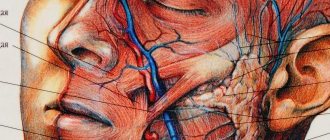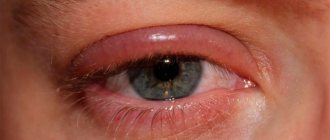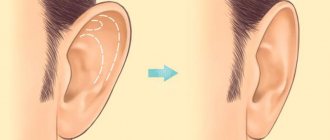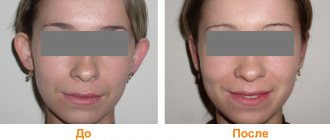Photos before and after Reviews Videos Rehabilitation Prices Analyzes Questions and Answers
Otoplasty
- a surgical operation, the purpose of which is to eliminate deformation and improve the shape of the ears. People of all ages suffer from deformation of the auricle (protruding ears) or asymmetry of the auricles. Often, protruding ears are an additional reason for ridicule from others, a cause of mental discomfort and poor adaptation to school.
You should not cover up your protruding ears by styling your hair lushly or hiding your ears under a hat; we advise you to decide to radically change the shape or size of your ears.
Indications for surgery may include your desire to restore your ears to their correct shape, get rid of protruding ears, increase or decrease the size of your ears, or change the shape of your earlobe. With otoplasty, your ears can be adjusted to meet your desired aesthetic needs.
Ear plastic surgery does not affect the patient’s ability to distinguish sounds, but at the same time, the shape of the ears is essential for sound orientation in space; due to this fact, the operation is indicated on two ears at once, and it does not matter that the defect may be only on one ear.
There are two types of otoplasty:
— Cosmetic ear surgery
. The aesthetic purpose of the operation is to change the size or shape of the auricle, correcting the shape of the earlobe. There is also a less common one;
— Reconstructive otoplasty
. A less common operation, the task of which is to restore the auricle (for example, after an injury).
After the operation, a lasting result is guaranteed, which eliminates repeated interventions.
The operation can be performed at any age (more precisely, from the age of 7), since by this time the ear cartilage is completely formed. Children tolerate the operation quite easily and recover quickly. It is recommended that the operation be performed before the child has not yet become critical of his appearance. This will save him from possible complexes in the future.
The complexity of such operations lies in the fact that it is necessary to achieve complete symmetry of the shape of the ears. This is where the skill and experience of the surgeon is demonstrated.
More photos in the BEFORE AND AFTER photo gallery
Large (big) ears
In physiognomy, large ears indicate that their owners are prone to philosophy and global thinking. They are very kind and sociable. They are willing to listen to the opinions of others on a topic that interests them. Calm, non-conflict. They live an interesting life, full of events and interesting meetings. In the family they are compliant, dutiful, and always meet the needs of their household members halfway. They are promoted in their careers only thanks to their hard work and broad knowledge in many areas. They do not tolerate being dependent on their superiors and never ask for concessions.
“December” are avid debaters, they always prove their point of view to the end, even if they know that they are wrong. Eternal fighters for justice, for the protection of those undeservedly offended. They have many friends and sympathizers, they find support from everyone. Great success is achieved in the professions of an investigator in particularly important cases, a lawyer, a jurist, and a human rights activist. The family does not strive for leadership; this is enough for them in the service. They spend more time at work. Comprehensively developed people who are fond of sports can achieve great success in professional sports. Natural drivers, they never get into accidents and have excellent reactions. Very explosive in extreme situations, they can show cruelty if pushed to their limits. They like to drink, but are never drunk.
“July” - calm, friendly, compliant. They cannot choose a life partner for a long time, they are very cautious and suspicious, and somewhat modest in communicating with the opposite sex. Talented in mathematics, they can devote themselves to scientific activities. They are unobtrusive, never interfere in other people's affairs, do not ask anyone for help, are too independent and proud. They cannot be called talkative, but if necessary, they show excellent oratorical abilities. They express their thoughts clearly and explain ideas clearly.
“Autumn” large ears in humans, and especially “October” ones, are very calculating and perform well in the field of professional activity. They are very attentive in their work and never make mistakes. They are physically hardy, have good health, and are stable. They do not like to complain about fate, they easily tolerate a lack of funds, they know how to be content with little if there is no opportunity to have more. They believe that everything can be achieved through their own labor. They are constantly looking for new technologies and improving existing ones. They try to raise production to a higher level, often devoting their entire lives to one business. They are vengeful, but they remember the insult for a long time, they do not know how to forgive. They experience failures greatly, but do not lose faith in the best. They carefully analyze the reasons for failures and find mistakes. They have an excellent ear for music and can be conductors.
What do big ears mean?
- Very large, large ears portend many minor troubles and complications. A person’s personal life very often does not work out, there is an unsuccessful marriage, failure on the love front. But at the same time, he does not have insoluble problems and troubles that lead to significant losses.
- Huge ears indicate that their owner will have a long life and a happy old age.
- Large, but not much larger than average ears are found in people who are capable of achieving a lot. Most often, such individuals are successful, and if they put in a little effort and determination, they will not only make a career and achieve material well-being, but also become famous in science or creativity. These people are lucky primarily in business, science or art. In their personal lives, they may face some disappointments, sorrows, and unpleasant surprises, which will lead to forced loneliness or misunderstanding.
- Large, fleshy ears portend great disappointment or loss that will change later life. Most likely, this is due to the closest relative, the child. But many pleasant events and joyful meetings are expected in your future. In addition, in the future you will not be lonely if you try to be a more restrained, calm person.
- Thin, large ears portend career success. In youth, success with the opposite sex. This does not always lead to the creation of a family. Most likely, a person with such ears and character will prefer loneliness, independence and autonomy. Family ties will attract him in later life. If a family is created in youth, then there is a high probability of divorce. Usually people with such ears have a long life and a happy old age, among loving family and friends.
Small ears
Small ears portend a hectic life, full of unexpected pleasant and unpleasant incidents.
Many adventures await such a person, especially if his life, work, and activities involve moving and traveling. A person with such ears will lead a rather frivolous life and commit rash acts. As a result, this will not only bring him troubles and unpleasant experiences, but also the happiness he dreams of.
Small, pale, beautifully sculpted ears portend a quiet life. Such a person will most likely make a successful career, achieve a lot financially, and will be respected by employees, friends, and acquaintances. But in family life there is a high probability of complications: disagreements and quarrels with loved ones are possible.
Symmetrical ears
Symmetrical ears are a sign of harmonious human development, asymmetrical ears are a sign of physical disharmony.
According to the ancients, everyone is dual in nature. Accordingly, there is a “good” ear (for men – right, for women – left) and a “bad” ear (for men – left, for women – right). It should be remembered that the right and left ears are different in the information provided. A “good” ear speaks of karmic achievements, a favorable balance.
So, for men, the right, “good” ear is the most important indicator. If anyone had any ominous signs, in ancient times such a person could be cursed or beaten with a stick.
First of all, you need to determine which ear a person has is more pronounced, at least slightly, more harmoniously (a harmonious ear is a whole ear, without breaks, even in shape). If it is an “evil” ear, then such a person is karmically more prone to evil and must realize negative karma.
Each of us has ears that are expressed approximately equally, and this suggests that a person has an equal chance of using both good and evil. Each ear symbolizes a cup from which we draw good and evil in order to use it in our lives.
Pointed ears
The shape of the auricle with a pointed angle at the end speaks of the contradictory character of their owners. The character of people with pointed ears is complex, quarrelsome, unyielding. It is difficult to make acquaintances, have few friends, it is difficult to build relationships with the team at work, and it is difficult to endure quarrels in the team and family. However, they are very responsible, committed, and hardworking. Depending on their first name and patronymic, such people may be devoted friends who never leave their friends in trouble, or they may have no friends at all.
Children with this ear shape are very irritable and easily excited. Parents should pay attention to their nervous system.
“January” people with pointed ears are difficult to communicate with, always dissatisfied with something, dissatisfied. They do not know how to accept criticism addressed to them, even fair ones. But they themselves love to criticize everyone and everything. They do not get along with colleagues too easily; they choose their own friends. They are fastidious and have a good sense of smell. Not every home can eat and notice the smallest details of food preparation. They achieve great results in sports, in any form, they are brave, fearless, hardworking. Such ears can be found on world champions and Olympic champions. In the family, such people try not to create conflicts; they have enough difficulties outside the home. They are unobtrusive, do not burden anyone with their requests, and do not like having their ideas or problems imposed on them. They are inquisitive, seriously interested in politics, and can devote themselves to political activities. They have a good memory, including visual memory. They have a tenacious memory and a sharp mind.
Those born in March are very vulnerable and sensitive. They try not to offend anyone, they are correct and tactful, they carefully weigh every word they say. They are intelligent and have a good upbringing. Show empathy for others. Devoted friends and partners, reliable, obligatory. Punctual, pedantic to some extent. Balanced, laconic, listen more than talk. They have something to say, but they are in no hurry to draw conclusions, and do not consider it necessary to tell everyone about their opinion. Many turn to them for help, and they do not refuse anyone. They find it difficult to build their personal life and may marry several times. They can't find their mate for a long time. It takes a long time to choose a companion for the first time, but rarely successfully. There are also troubles in the team, it is difficult to find a common language with them and come to an agreement. They do not tolerate falsehood, hypocrisy, or toadying. They don’t engage in scams and have difficulty compromising. With some names and patronymics, such people can be too cruel, capable of murder if they are thrown out of balance. Basically, such people are good diplomats and psychologists. They know how to build a dialogue, but only for the sake of a common cause. In a private conversation, they behave completely differently.
“July” people with pointed ears are very active and energetic. The nervous system is unstable. Impatient people may interrupt their interlocutor, finishing his thought. They like to sleep in the morning, have difficulty waking up, and I don’t recommend waking them up. They are goal-oriented and know how to plan their time. They have many friends, love interesting company, and will not miss a single party, official reception, or presentation. Women deliberately marry late, are very independent, and always rely only on their own strengths. They love animals and have small breed cats or dogs in the house. However, they pay little attention to their pets and do not like to walk with them.
Plastic surgery of the auricle
Most often, patients seek correction of the shape of the auricle due to its deformation. Deformities may already occur at birth or occur over time.
Congenital deformities appear as a result of negative influences on the embryo during the formation of its external ear. Among them are:
- Microtia. The auricle is underdeveloped. As a result, a person is born with small, ingrown or flat ears.
- Macrotia. Excessive growth of cartilage tissue, leading to significant enlargement of the ears.
- Curled ears. Occurs when part of the cartilage tissue is bent downward or forward.
- Prominent ears - an increase in the distance between the ears and the skull.
Acquired deformities result in trauma, chemical and thermal damage, inflammation, and post-inflammatory growth of the skin on the auricle.
Auricular plastic surgery is a difficult operation, performed in several steps with intervals of 2-3 months. This duration is determined by the complexity of the topography of the auricle, the lack of parotid tissue and significant scarring of the operated area. Usually such an operation is performed under general anesthesia, but in less severe cases local anesthesia is used. To form a new base of the auricles, as a rule, material is extracted from the costal cartilages.
Fleshy ears
In physiognomy, too fleshy ears are more often found in people who are gloomy, taciturn, and withdrawn into their own little world. In extreme situations, such people can be tough and even cruel. Fleshy lobes that lag far from the neck muscles indicate the strong will of such people. They are brave, decisive, strong in nature. Often such ears can be found on professional athletes involved in strength sports: wrestling, heavy weight barbell. These people are very kind to family and friends, love cheerful companies, and are known as kind-hearted and witty. But I don’t recommend testing their patience.
“February” people with fleshy ears have a difficult time building their lives, especially their personal lives. They can marry several times, but for a long time they fail to create a strong family. Such people are not very sociable, secretive, do not like to talk about their personal lives, and do not share their problems even with loved ones. Very hardworking, stubborn, assertive. They have good reactions and are well oriented in any environment. They do not tolerate lies, they can explode and cause trouble. They are inclined to take justified risks, practical and calculating. If it is profitable for them to undertake something, they will make every effort to achieve success, if not, they will never get involved in a dubious business. Determined, they do not waste time if they want to achieve something. They do not tolerate optionality; those who want to carry them out may end up badly. They love to admire themselves in the mirror, have a perfect haircut, are always elegant and fit. They begin to turn gray or even go bald early. They are devoted to their relatives, adore their parents, and never forget about them.
How can you tell a person’s character by the shape of their ears if they were born in March? People with such ears are somewhat awkward and clumsy. Very vulnerable, too squeamish. They do not like to visit, they are homebodies; only very large events can force them to visit friends or acquaintances. Such people have good intuition, bordering on foreseeing events, but they do not believe in fortune telling at all and are wary of astrologers and psychics.
Women with such ears also find it difficult to arrange their personal lives and are in several marriages. They often have children of different sexes and from different marriages. They are very inquisitive, read a lot, are interested in everything, and have extensive knowledge in all areas. Inveterate debaters, who prove that they are right to the bitter end, are very upset if they fail. Many have good musical abilities and sing well. They love drinking songs and are happy to fulfill their friends’ requests to sing.
“October” women are very calculating, observant, and practical. With certain first names and patronymics, women have an adventurous character and realize themselves well in the political sphere of activity, in economics, and business. They are contactable and communicative. They get along well with men. They have a good figure and bright personalities. Attractive to men. Easily promoted. Wonderful actresses. They are jealous and unceremonious; if they catch their lover cheating, they can publicly stage a scene of jealousy. They love flattery, praise, and compliments. However, despite all women’s weaknesses, they have a masculine mentality and possess iron logic. They achieve great results in their professional activities and occupy high positions.
Types of otoplasty
Today, changing the shape of the ears in otoplasty is carried out using three methods:
- Laser plastic surgery. Refers to a new technique in which incisions during surgery are made using a laser beam. This method has a number of positive results: firstly, the procedure lasts no more than an hour, secondly, the recovery period passes quite quickly, and thirdly, the laser leaves almost no scars.
- Scalpel plastic. It is an old technique in which the surgeon uses a scalpel. And although this method is considered very effective, it has many disadvantages: a lengthy operation (up to two hours), a long recovery period, and scars subsequently remain in the areas with incisions.
- Radio wave plastic. This is an innovative technique that allows you to make cuts using radio waves. During such an operation, the patient is not injured, and there is no bleeding during the incisions, which contributes to quick recovery after the procedure. Here, recovery takes place in a maximum of three weeks. Radio waves do not leave behind scars and have a bactericidal property, leading to rapid healing of the operated area.
What do ears say about a person?
The table below gives the main guidelines for determining a person’s character by their ears:
| Ear type | Personality/destiny |
| Full, firm, large, brightly colored | Nobility, prosperity |
| The outer and inner rims are well rounded and well balanced | A very successful way out of poverty in middle age |
| Well rounded, firm, full, close to the head, set above eye level, bright in colour. | Ideal type for a very successful career |
| Relatively small bezels, almost invisible from the front | Enterprising type, high position with power |
| The outer rim seems to be flying away, the middle ear sticks out | Endless hard work, no outside help, never earns much |
| Absence of an inner rim, the entire ear protrudes forward, the lobes are weak | Violent events at the end of life |
| The outer rim is flat and wide open, the inner rim is the opposite, the whole ear is located low | Encounter with the law in youth, constant poverty |
| The ear is located quite high, but its middle part has grown, covering the lobe | Inability to save money, endless, exhausting work |
| The top of the ear is relatively small, but located above the level of the eyebrows and is lighter in color than the face and earlobe | Wide fame, prosperity, life to old age, death without issue |
| Ear type | Personality/destiny |
| The top of the ear is above the eyebrows, the outer rim is directed outward, bent back | Pleasant life until old age, death without offspring |
| The ear is large, the apex is round, at the rear. pointed lobe | Lack of intelligence, thieves, hooligans, scammers |
| The ear is located above eye level close to the head, the outer rim is hard | Nobility, wealth, great glory through generations |
| The outer rim is worn, thin, not massive | Waste of inherited or acquired wealth, poverty in old age |
| Floppy ears tilted forward | A good life in youth, good success in middle years, poverty and loneliness in old age |
| The top of the ear is located above the eyebrows, full outer and inner rims, shoulder-length lobes, round head, large forehead | Nobility, high position, life to old age |
| Good outer and inner rims. soft lobes, slightly extending back | Daily work, poverty, failures in old age |
Determining character by ear size
In physiognomy, the size of the ears is also of great importance in determining a person’s character.
- Large ears are considered good when they are balanced with other factors including thickness, softness, grace of form and radiant coloration of the ear. People with such ears can achieve success. But excessively large ears, poorly shaped, colorless and covered with rough skin are a sign of an evil personality. As a general rule, ears that are too large and not in balance with other facial features indicate a vain, stubborn nature.
- Ears that are smaller than normal and not in balance with the rest of the face indicate a slow-witted and dull person. Due to their nature, such people are easily influenced by others and lack decisiveness and self-confidence.
- If a small ear has a rim with a defect, then this indicates a treacherous personality.
- Unusually small ears in a person of great intelligence, with a high forehead, strong eyebrows, and domineering eyes indicate a person who cannot be trusted, prone to violence and often has a criminal nature.
- How to determine a person's character by their ears? Thin and soft ears with low mass indicate a tendency to take unjustified risks in business. Most observations say that ears with a small mass indicate a lonely person. Soft ears with the inner rim turned outward indicate a lustful, voluptuous person who is sexually promiscuous. If such a soft ear is tilted forward, then it indicates a very tolerant person, indulgent, indulgent in pleasure, and sometimes obscenely lustful.
- How can you tell a person’s character by the pointed shape of their ears? These ears are relatively common and come in a variety of shapes. Pointed at the apex, they indicate a person of destructive nature and low intelligence. If the ears are pointed and excessively small, then this indicates a stubborn and cruel character.
- The rim or edge of the ear must not have any defects. If the rim is small and soft, then this indicates that the person is weak and lacks willpower. If it is round, smooth and balanced with other facial features, then this indicates a happy person, with a wonderful character and close family ties. When the rim, external, internal or middle, is clearly outlined, then this indicates intelligence or early development at a tender age. Ears with heavily ruffled outer rims—called “cauliflower” in the West—indicate a courageous, determined individual with an independent mind. Such people, in the literal sense of the word, conquer their destiny.
- Reddish ears affect a person’s character - a stormy life filled with adventures and unusual incidents will lead to a not very pleasant ending. If a person does not change, he will face loss, loneliness and significant health problems.
- Ears that fit tightly to the head - this person will be able to achieve a lot in life. If he sets a goal for himself, he will stubbornly go towards it, no obstacles will stop him on the way. That is why we can say that he will achieve everything in life not so much due to fate’s favor to him, but because of his own perseverance and unbending character. Most likely, such a person does not have much success in his environment (at work, among friends), but close, knowledgeable people value and respect him.
- If the ears are proportional and neat - success in love, special attention from the opposite sex. But it is quite possible that the first marriage will be unhappy. Problems and complications in relationships are likely, which can lead to divorce. Such a person will have several successful periods of life. At this time, he will be successful in everything. But the ups are certainly followed by moments of decline, deep disappointment and difficult experiences.
- How to determine a person's character by round ears - a calm, long life. Sometimes it may seem to a person not so much prosperous as rather boring. Some variety can be considered minor family troubles and complications. But in the future, there may be some surprising, out-of-the-ordinary event that will change a person’s whole life if he decides to take a risky step. With such a development of events, a person is able to achieve a lot.
- Cartilaginous ears portend a happy family life, pleasant experiences, and incidents associated primarily with loved ones. To a person with such a trait, if he strives for love, fate gives him an all-consuming feeling that will become the main thing for him. Success comes in relationships with people. He is likely to have many loyal, devoted friends.
When studying the structural features of the ears of long-livers, we were able to identify an interesting fact. It turned out that in 85% of cases, people over 90 years of age are characterized by three reliable signs: large, somewhat elongated ears, an elongated and thickened earlobe, and a convex ridge of the antihelix.
Changing the shape of the earlobe
Earlobe correction is a surgical process aimed at changing the size or shape of the earlobe. The average duration of the operation is 30 minutes, the procedure is performed under local anesthesia. As a rule, earlobe plastic surgery is necessary:
- When the skin sagging due to loss of elasticity;
- When the puncture site for earrings expands due to prolonged wearing of jewelry;
- If the earlobe is damaged due to injury or serious illness;
- With congenital defects, such as asymmetry, bifurcation of the lobe, if its size is too large or too small;
- For stretched lobes, which can result from wearing “tunnels”, which are very popular among young people today.
During surgery to correct the shape of the lobe, most often the surgeon removes part of the tissue and then sutures the lobe. If there are injured areas on the ear, they are also excised, and then the skin tissue is stitched together. The recovery period after such a procedure lasts from 10 to 12 days and may be accompanied by discomfort, mild pain and minor swelling.
How to tell your character by your ears
- Shapelessness and pallor of the outer ear indicate unfavorable factors, and flabby and lethargic ears indicate weakness of the body, which does not exclude stomach cancer.
- Huge-sized ears (“donkey ears” of King Midas), called macrotia, are observed with various personality flaws.
- Moderately large ears with well-defined convolutions indicate musical ability. Protruding, large ears (protruding ears) are quite common and to a certain extent indicate the stupidity and ingenuity of the subject.
- Highly set ears (the top line of the auricle is higher than the eyebrows) are a sign of powerful intelligence.
- If the tops of the ears are at eye level, the intelligence is above average; low placement of the ears (tops below eye level) indicates average and even insufficient development of the mind.
- How can you tell a person's character by the shape of their ears? Large, thin, protruding ears indicate musical talent, especially if they are also hairy.
- Small, fat - about the absence of such abilities; flattened ears sometimes betray pettiness, inconstancy, vindictiveness, and deceit.
- Long, narrow ears occur in people who are disorganized, unable to concentrate, often stingy, and envious.
- If the ears are also thick, you are most likely a limited person.
- Gifted people have wide and thin ears. “Wolf” ears pointed upward indicate rudeness and cruelty.
- The fluff on the ears characterizes the passion of nature.
- The inner rim of the ear is an indicator of emotional self-expression. More hidden behind the outer rim means restraint; convex - impulsiveness. The normal ear color is pink.
- Blue or yellow ears are a sign of illness.
- Hard, firm ears indicate good health and longevity.
- Soft, flabby ears are a sign of weakness of connective and cartilaginous tissues and poor health. Interestingly, the hardness of the ears varies from month to month, reflecting the general condition of the body.
- Full, hard ears, long, close to the head and rising above the eyebrows, with a wide ear canal and fleshy lobes, light or pink in color, are considered favorable.
- If the ears do not correspond to this description or the inner circle of the auricle is not clearly defined, their owners are at risk of health problems, their fate will be less fortunate than that of people with favorable ears.
- Flabby, flabby ears are a sign of weakness in the body (stomach cancer cannot be ruled out).
- Large ears with an elongated auricle, an elongated thick lobe, and a convex ridge of the antihelix - these are the ears of a long-liver.
- Ears with deep pinnae, large dense lobes and split tragus are evidence of wisdom.
Contraindications
Ear plastic surgery, like any similar operation, is a direct surgical intervention, so it is important to pay attention to contraindications. This procedure is not possible if:
- Inflammatory processes of the skin around the ears;
- Outbreaks of chronic diseases;
- Poor blood clotting;
- Acute infectious diseases;
- Pregnancy;
- Oncology;
- Endocrine disorders;
- Diabetes mellitus.
What the ears say about the personality and its character
Wide bore ears
A passage is considered wide if you can fit 1-2 fingers there. A wide passage speaks of intelligence, generosity, nobility, openness and long life. People with such ears love to gain new knowledge, they are very sociable, and they are democratic leaders by nature. The best ears are those with hair growing in them.
Ears with a narrow passage
A passage is considered narrow if even one finger does not fit there. The owner of the ear is considered to be dull, secretive, conservative and stingy. Businessmen often have such ears. But people with such ears do not live long because they are constantly under stress. Softening features can be a large distance between the eyebrows and well-shaped eyes.
Ears with small lobes
These ears have short and thin lobes. It is believed that a person has very little vitality and is unhappy. These are people with complex characters, they do not get along well with other people, and often quarrel. They have to work hard for little money. They rarely make a career.
Rectangular ears
Ears that have corners at the top and bottom are considered rectangular. Ears of this shape are an indicator of strength, health, lust for power and the ability to achieve one’s goals.
Ears set high
How can you tell a person's character by the shape of their ears? If the upper part of the ear is located above the level of the eyebrows, its owner is endowed with intelligence, often talent, will most likely live a long life, and can make an excellent political career.
Ears set low
In this case, the earlobe is located below the end of the nose. It is believed that people with such ears are very persistent, stubborn, purposeful, and they also live a very long time. The first part of their life is full of difficulties, but the second is illuminated with happiness.
Ears with convex circles
If both circles in the ear - the inner and outer - are clearly visible and even protrude, then the person has ambition, energy, is very assertive and is able to unite people.
Ears with a convex outer circle
The outer circle is responsible for the mind and health. If a person’s circle is clear and prominent, then the person has talents that he does not intend to make money from. Most often, people who choose liberal professions have such ears.
Ears with a convex inner circle
People with similar ears are destined for a political or financial career. But a strong bulging of the inner circle shows ambition with little intelligence and not very good health. Both of these factors can prevent you from achieving success.
Correction of protruding ears (protruding ears): whim or necessity?
People, and especially children, with protruding ears are often the target of ridicule. Of course, not everyone is worried about this. Some manage to make such a lack of appearance their exclusive feature. But what should those who constantly feel psychological discomfort due to deformation of their ears do?
Let's talk about this with Arunas Jankauskas, a plastic and reconstructive surgeon from Northway Medical Center .
Are protruding ears a common problem?
Protruding ears are one of the most common congenital deformities of the head and neck. About 5% of people have protruding ears. Prominent ears become noticeable after the birth of a child. Over time, as the child grows, this problem becomes more noticeable.
What determines the shape of the ears?
We inherit the shape and size of our ears from our parents and grandparents. It depends on the genes. The formation of the ears begins at 5-6 weeks of pregnancy, and all their elements become pronounced until the 20th week. There are two most common causes of protruding ears. If the upper part of the auricle has not developed, then the antihelix (the curve of cartilage that runs along the ear) does not form, and then the helix (the outer edge of the ear) remains protruding forward.
The second reason is the too rapid growth of the central part of the cartilage (concha), as a result of which the antihelix is formed incorrectly and the entire ear looks protruding. It is these reasons, each individually or both in combination, that predetermine protruding ears.
Protrusion is objectively stated when the edge of the ear is more than 2.5 cm from the head, and the angle between the auricle and the head is more than 30 degrees. There are patients who, in addition to protruding ears, have other pathologies, for example, an undeveloped ear canal or concha, or not all the formed bends.
Is surgery the only way to fix protruding ears?
Of course, you can’t hope that by wrapping a scarf around a child’s ears at night, they will be close in the morning. This deformation cannot be corrected by fixing it with glue or adhesive. The only effective way to solve this problem is plastic surgery.
Who most often applies for correction of protruding ears?
As a rule, patients of three age categories address this problem: children aged 5-6 years, adolescents 12-16 years old and adults. Parents bring their children in preschool age so that peers do not bully him and the child does not feel psychological discomfort. Teenagers are driven to the doctor by increased self-criticism and the need for beauty. But we also have to operate on a considerable number of patients who decide to undergo surgery at an older age, who were ashamed of their protruding ears for many years. Both men and women turn to otoplasty, and either one ear or both ears are subject to correction.
At what age would you recommend having this surgery?
It is not recommended to perform ear correction in children under five years of age for cosmetic reasons in the absence of other indications, because It's still a surgical operation. Until this age, the ear continues to grow and certain growth areas can be damaged. A child's ear at the age of 5-6 years becomes almost the same as that of an adult, so this age is suitable for surgery. If the deformity is very noticeable, it is better to have surgery before starting school. This will help avoid ridicule from peers and prevent the occurrence of psychological problems on this basis.
Children are always beautiful to their parents, and not everyone notices that protruding ears can bother a child. In our society there is an established standard of beauty, and children can be extremely merciless towards those who look a little different, they become the object of ridicule and receive different nicknames. Adults do not react to this problem so acutely, but if a person believes that correction of the defect will improve his well-being and increase self-esteem, then he really should contact a plastic surgeon and decide to have surgery. Only before the operation is it very important to find out how a person imagines himself after it, what wishes he has and whether they can be realized. A plastic surgeon can only fulfill the real wishes of patients, because the ear is not plasticine and no one will fashion him a new one.
Do protruding ears affect your hearing in any way?
In fact, this is an aesthetic problem with which you can get along just fine, since protruding ears do not in any way affect hearing, intelligence, or any other character traits. Only in very rare cases can the ear canal be narrow, and this can affect hearing loss.
Why are surgeries performed if protruding ears do not affect health?
The main reason is intolerance from surrounding people, which can cause psychological problems. Children with stronger character defend themselves and strengthen themselves, but most children cannot do this, and constant ridicule affects personal development. Children begin to avoid their peers and withdraw into themselves. In this case, surgery is the best way out of the situation. After the operation, I saw tears of joy, which shows how important this is for people.
Why is surgery usually performed on both ears?
Sometimes one ear protrudes more than the other, so quite often they ask to operate on only one ear. But for more accurate symmetry, it is recommended to operate on both ears. This way you can prevent additional stress and avoid another operation.
How is the operation performed? How long does the healing period take?
The operation takes about one and a half hours. For young children, surgery to correct protruding ears is performed under general anesthesia. Local anesthesia is used for children aged 12-14 years, depending on their character, as well as for older people. Long-term anesthetics are injected into the area behind the ear, so the patient hears various sounds and crackling sounds, but does not feel pain. During the operation there is often time to chat and laugh.
Surgery to correct protruding ears involves softening and fixing the cartilage of the auricle in a different position. A few hours after the operation, the patient can go home, and if local anesthesia is used, immediately after the operation. The next day you need to come for a dressing. The stitches are removed after a week. When operating on children, the skin is stitched using absorbable threads, so there is no need to remove them. Once the stitches are removed, a bandage is not needed, so you can return to school or work. Only at night for a month you will need to wear a support bandage and sleep with it. During this time, the ear will heal completely.
The surgical incision is made behind the ear, so after the stitches are removed, only a small scar will remain, which will become almost invisible after 4-6 months.
Does seasonality somehow affect the outcome of this operation?
The seasons do not affect the outcome of the operation in any way. But a person planning to undergo this operation needs to be aware that minor swelling and sensory disturbances may last for several months. During the cold season, due to increased sensitivity to cold, it is necessary to wear a hat. After the operation, it is not recommended to engage in contact sports for 1-2 months; you can swim in open water after 2-3 weeks. It is recommended not to be in the area exposed to sunlight for several weeks after surgery.
Are there any complications after such an operation?
As with any surgical intervention, bleeding is possible during the first two days after surgery, so it may be necessary to change the dressing several times. In very rare cases, the operated ear partially protrudes or knots of fixing threads become noticeable. In such cases, a repeat operation is performed.
Return to all articles Share:










